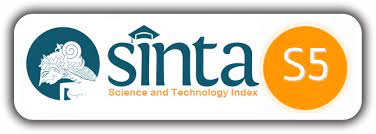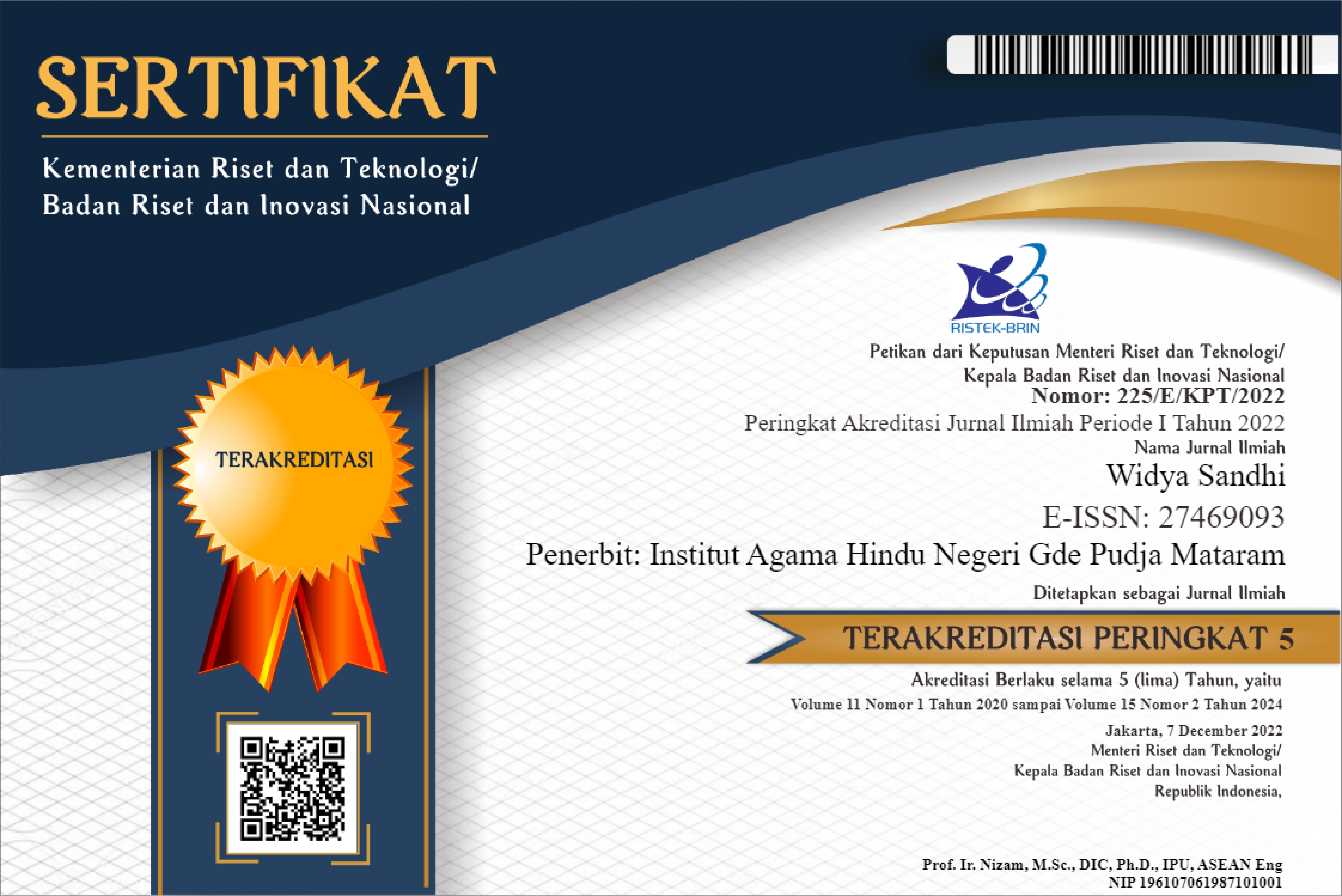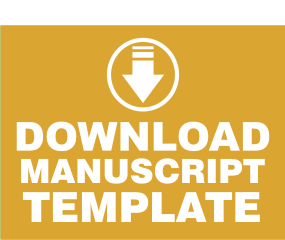INTERNALISASI AJARAN YAMA DAN NIYAMA PADA SISWA MELALUI EKSTRAKURIKULER YOGA DI SEKOLAH MENENGAH PERTAMA DWIJENDRA MATARAM
Abstract
Today, yoga has become a world icon as a system of physical exercise that has been practiced by people from diverse backgrounds and has been integrated with their respective social cultures. In fact, especially in Indonesia, yoga has been directed to the formal education is packed in the form of yoga extracurricular activities and not infrequently as a competition and art performances which are integrated with acrobatic art. Yoga has a foundation of universal ethical values called Yama and Niyama which should also be internalized so that yoga is not just a system of physical exercise only. This research researching how to internalize the teachings of Yama and Niyama to the students through the yoga extracurricular at Dwijendra Mataram Junior High School (SMP Dwijendra Mataram) so that known the type of Yama and Niyama teachings are internalized, the supporting and inhibiting factors the internalization process, and know the implications of Yama and Niyama teachings that are internalized. This research is qualitative research by using phenomenology approach. Informants were determined purposively. Data were collected through observation, interview and documentation method, then analyzed by data reduction, data display, and drawing a conclusion. While checking the validity of data that includes credibility, transferability, and dependability, done by using source triangulation techniques, method triangulation, and theory triangulation. The research results obtained, firstly, types of Yama teaching that is internalized is anresangsya. While the type of Niyama teachings that are internalized include ijya and tapah. Secondly, internal support factors include the high interest of the student and better mental characteristics than in previous years, while the external support factor is the role of teachers, yoga extracurricular mentors, and headmaster. Then the internal inhibiting factor is that there are still some students whose interests are low, while the external inhibiting is a simple yoga mat so that the comfort of the exercise has not been guaranteed to the fullest. Thirdly, the teachings of Yama and Niyama that are internalized in the students have an implication to increased student learning motivation and moral ethics.
References
Bertens, K. 2007. Etika. Jakarta : PT Gramedia Pustaka Utama
Darmawan, Rahmat. 2004. Kundalini Dharma Yoga, Tuntunan Praktis Pendayagunaan Radiasi Kundalini &Penyembuhan Cakra. Jakarta : PT Gramedia Pustaka Utama
Djamarah, Syaiful Bahri. 2011. Psikologi Belajar. Jakarta: Rineka Cipta
Gintings, Addorrakhman. 2010. Esensi Praktis Belajar dan Pembelajaran. Bandung: Humaniora
Iyengar, B.K.S. 1980. The IllustratedLight on Yoga, Yoga Dipika. New Delhi: HarperCollins Publishers
Irawan, Prasetya. 2006. Penelitian Kualitatif & Kuantitatif Untuk Ilmu-Ilmu Sosial. Jakarta: Departement Ilmu Administrasi FISIP-UI
Kinasih, Arum Sukma. 2010. Pengaruh Latihan Yoga Terhadap Peningkatan Kualitas Hidup. Jurnal Buletin Psikologi Volume 18, No. 1, 2010 halaman 1-12, Fakultas Psikologi Universitas Gadjah Mada ISSN: 085-710 (dalam
http://jurnal.ugm.ac.id, diunduh pada 15 Februari 2017)
Krishna, Anand. 2015. Yoga Sutra Patanjali Bagi Orang Modern. Jakarta: PT Gramedia Pustaka Utama
Saptono. 2011. Dimensi-Dimensi Pendidikan Karakter. Salatiga: Erlangga
Suhardana, K.M. 2007. Yama Nyama Brata, Panca Yama Nyama Brata, Dasa Yama Nyama Brata. Surabaya : Paramita.
Suwantana, I Gede. 2011. Petikan Dawai Wedanta (Indra Udayana Vicharamritam-2). Ashram Gandhi Puri Indra Udayana Institute of Vedanta
Suwantana, I Gede. 2016. Perkembangan Yoga Di Seluruh Dunia, Alasan dan Kritiknya. Dalam Prosiding Seminar Nasional “Kemanfaatan Latihan Fisik Dalam Meningkatkan Kesehatan Jasmani Dan Rohani Menuju Kesempurnaan Hidup” Selasa, 31 Mei 2016. Institut Hindu Dharma Negeri (IHDN) Denpasar
Uno, H. Hamzah B. 2011. Perencanaan Pembelajaran. Jakarta: Bumi Aksara

This work is licensed under a Creative Commons Attribution-NonCommercial-ShareAlike 4.0 International License.
Authors who publish with this journal agree to the following terms:
- Authors retain copyright and grant the journal right of first publication with the work simultaneously licensed under a Creative Commons Attribution-ShareAlike 4.0 International License. that allows others to share the work with an acknowledgment of the work's authorship and initial publication in this journal.
- Authors are able to enter into separate, additional contractual arrangements for the non-exclusive distribution of the journal's published version of the work (e.g., post it to an institutional repository or publish it in a book), with an acknowledgment of its initial publication in this journal.
- Authors are permitted and encouraged to post their work online (e.g., in institutional repositories or on their website) prior to and during the submission process, as it can lead to productive exchanges, as well as earlier and greater citation of published work (See The Effect of Open Access).






.jpg)




